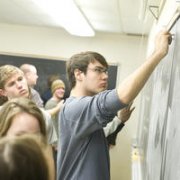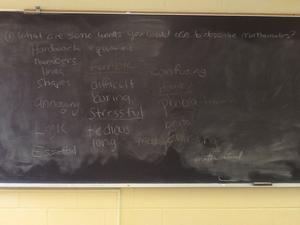Audience: Learning about our MLA students
Written by: Dr. Phil Hotchkiss
Mathematics for liberal arts (MLA) students are a wonderful and rewarding group with whom to work, however, the wide variety of skills and interests (which change from semester to semester), as well as the negative attitudes toward mathematics can provide some unique challenges and make the prospect of working with these students a daunting task. This month's blog will discuss some of the techniques I have used to get to know my MLA students and successfully engage them in mathematics. Let me start with a short overview of what many students bring to the class, and tools we can use:
| Feature | Tools |
|---|---|
| Mix of Majors | auto bio, gallery walk |
| Math Anxiety | auto bio, gallery walk, norms, emotional support |
| Creativity | flexibility in topics, posters, projects, focus on writing |
| Low confidence | group work, reflection, lament, good problems |
| Low Persistence and Little Ownership | stepping back and asking good questions |
Mix of Majors
Before I start teaching any class, I need to know who my students are. In MLA classes especially, each semester can bring a totally different mix of majors. To address that need, my first activity is a gallery walk. For this activity I write 6-8 questions on the blackboards around the room (we have wrap around blackboards) and then break the students into same number of groups as questions and have the groups rotate around the room and write their answers for each question on the boards. (Document with ![]() Gallery Walk: Questions. For more details, see our blog about gallery walks.) I learn about who is the classroom from the questions about what students like to learn about and and what they find worth knowing.
Gallery Walk: Questions. For more details, see our blog about gallery walks.) I learn about who is the classroom from the questions about what students like to learn about and and what they find worth knowing.
Math Anxiety
Another question in the gallery walk is "What are some words you would use to describe mathematics?".
Typical answers include boring, scary, horrible, stressful, hard, frustrating, and exhausting. Almost every word either describes a negative attitude or an aspect of mathematics such as arithmetic. It is very rare that a student writes down a word describing a positive attitude toward mathematics.
I also assign a mathematical autobiography the first day and ask the students to share their biographies the next class. Our blog on mathematical autobiographies includes two complete autobiographies:
![]() Mathematical Autobiography Example 1,
Mathematical Autobiography Example 1,
![]() Mathematical Autobiography Example 2.
Mathematical Autobiography Example 2.
The following are typical comments from the hundred or so biographies I collect each semester:
Incoming MLA Student perceptions about mathematics:
“Let me just start with the fact that I’ve attempted college at least three times. I swear every failed attempt is due to Mathematics.”
“As it stands, I'm terrified of this class.”
“For me personally doing math is immediately associated with struggle and hardship. It feels like no matter how I try I am unable to firmly grasp math as a whole or as its individual formulas. Math has always felt like a weight I am unable to lift.”
While these attitudes are not uncommon for non-MLA students (some of my pre-service elementary education majors feel the same way), their prevalence makes the MLA audience very different. Many of these students have been disfranchised by their mathematical experiences. By and large, they have been damaged in their previous mathematical experiences and their math anxiety is through the roof.

This anxiety, left unaddressed, can form a significant barrier to the successful completion of the course. The gallery walk and biographies are an important component of my course because it allows the students to bring these feelings and fears out into the open and not have to pretend they aren’t there. It also provides an opportunity to begin a discussion about why these feelings are so widespread and how they impact my students' mathematical growth. It can help to be explicit about the classroom norms, e.g. to not judge each other, to not ridicule anybody's contribution, but instead to support each other and work as a community. Finally, as a facilitator it is also my responsibility to support the students emotionally. I'm basically a "math therapist" (which is a whole other blog in itself).
Creativity
In my MLA courses I am not bound by specific content goals. As a result, I can focus on areas of mathematics that seem more relevant to my students. By exploring links between mathematics and the liberal arts my students are able to make and utilize connections to their areas of interest.
I enjoyed the comparison between art, music and math because it gave me a glimpse at how mathematicians see math. It took music, which is something I can closely relate to, and math which is something I am not passionate about and it allowed me to see what it would be like if music were taught in the same fashion as math is.
I also have the freedom to allow students (or the entire class) to pursue interesting questions that they ask which may take me away from the original goal I had in mind.
Moreover, many of my students are used to using creative ways such as poems, songs, stories, art or posters, to show what they have learned; which in turn can make assessment more varied and interesting (see also assessment techniques).
In the following video Woody shares a sonnet he wrote as part of his project "The Mathematics of Poetry". Each line of the sonnet relates to one of the other student projects.
This flexibility allows me to address cognitive and meta-cognitive goals such as reading, writing, reasoning, and problem solving.
Low Confidence
As I get to know my students, other characteristics become clear. Many MLA students typically have little or no confidence in their mathematical ability-- although there may be a wide range of abilities. Even the students whose mathematical thinking is very good believe they are not good at mathematics. If my students have any mathematical confidence at all, it is based purely on their algorithmic ability. Moreover, they expect boring, incomprehensible lectures, brutal exams and that they will barely pass the class even though classes in their majors may be very different. These characteristics make teaching an MLA course very challenging. These students believe that this course will be the worst course of their semester, if not their entire college career. They also believe that I don’t care whether they pass or fail.
To make this course successful for my students, these beliefs and preconceptions need to be challenged. IBL provides a way for my students to confront and deal with these crippling notions in a constructive way. The decentralized structure allows me to transfer the mathematical responsibility to the students and as they work in groups though the Investigations, they find that they can successfully do mathematics.
Reading and reflecting about ![]() A Mathematician's Lament” by Paul Lockhart allows students to blame the system for their prior struggles with mathematics instead of blaming themselves. They also realize that there is a difference between "doing mathematics" and "following procedures". They are now ready and open for a new start with doing mathematics.
A Mathematician's Lament” by Paul Lockhart allows students to blame the system for their prior struggles with mathematics instead of blaming themselves. They also realize that there is a difference between "doing mathematics" and "following procedures". They are now ready and open for a new start with doing mathematics.
Of course, it's our job as facilitators to challenge our students with accessible problems at just the right level of difficulty (a future blog will describe how we fine-tuned our Investigations for the "String Art" materials in this regard).
Low Persistence and Little Ownership
My meta-goals (all the goals that are not content goals) include confidence, but also persistence and ownership; see Student Goals. In order to empower students, I need to step back as the authority. The stepping back and coaching rather than lecturing allows me to observe how my students think mathematically and better understand how to help them. For example, I usually answer their questions (fishing for answer) with another question (Good Questions blog) . I find this role in this classroom refreshing and invigorating. I love the fact that every semester I learn something new from my students.
The fact that it was never easy to find an answer to the problem made me want to find it so much more. I would sit at my table with my three classmates and work so hard on one problem until we got the guts to ask for help. But we were so personally determined to get the answer ourselves that we almost did not want to hear what we were doing wrong. And even when we asked for help, we were never told the answer. Rather we were given suggestions to turn different corners to possibly find the answers there. It taught us to think for ourselves. And it taught us so much more than just the way to get the answer to certain problems. The worst feeling in the world was to look up at the clock and realize that class was over seven minutes ago and you still have not figured out the solution. Yet the best feeling was when you figured out a solution and could not stop smiling for the rest of class because you had figured out that one question that had been pushing on your shoulders since the first time you read it.
Even though MLA students can be some of the most challenging with which to work, I find them to be among the most rewarding students with whom I work. It is gratifying to see so many of my students experience mathematics in such a different way that they begin to believe that they are capable of doing mathematics and that mathematics can be interesting.



